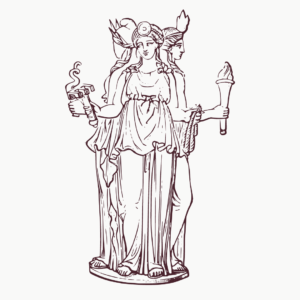Hecate
Hecate is a goddess and the primary and originating deity of the religion of Hycathism, whose name and lexical variants are derived from hers. She figures into the mythology of several other world cultures, but her importance to Hycathism is most widely felt in the several sociopolitical innovations and revolutions wrought in her name.
Origins and Symbolic Associations
Various beliefs subsist that Hecate originated either from the Caria region of Anatolia or from Ancient Greece, mostly due to cults led in her name across these regions. Some have suggested an Egyptian origin for her name at least, from the fertility goddess Heqet.
Hecate has most reliably been depicted in triplicate, be that with three bodies or with three heads. This image is intertwined with her roles as a liminal goddess – of boundaries, thresholds, entrances and crossroads – and also as a chthonic goddess – of the Underworld. Keys and torches often accompany these associations, particularly when Hecate is supposed to mind or guard an entrance or threshold. Classical epithets of Hecate may reflect these intersecting symbols, such as the Greek ‘Enodia’ (‘she on the way/road’) or ‘Triodia/Trioditis’ (‘who frequents crossroads’), and the Roman ‘Trivia’ (‘three ways’). The Romans sometimes saw Hecate as a triple deity, representing the Underworld alongside Luna (the Moon), representing the sky and Diana (hunting), representing the earth.
Hecate is often associated with symbols of nature, with many animal and plant symbols recurring in artistic depictions and accounts of ritual worship. Animals that recur are dogs, polecats, snakes and the red mullet, whilst often-mentioned plant life ranges from trees such as the yew, the cypress and the oak to garlic and to plants such as belladonna, dittany and mandrake from which medicines or poisons may be derived. These natural symbols also interact and intersect with her triplicate, liminal and chthonic qualities: the cypress is symbolic of the Underworld, whilst dogs may feature as a guard animal at thresholds or as a means to dig up mandrake roots.
Hecate and Hycathism
Birth of the Hycathae
The Hycath Mythos contends that Hecate, in around 3500 BC, foresaw a catastrophic event in the far future and descended to the Underworld to take preemptive action, retrieving eight female souls. She withheld the ability to see into the future because she knew such an ability would be too much to bear, but the eight selected souls were nevertheless bestowed with incredible powers and became the first Hycathae and the original Nyridiae, from which the less powerful Cynthae and Baethlae have since descended. These first Nyridiae were sent to eight of the world’s most powerful realms, with each being ruled under a separate central tenet. These were Care (Greece), Respect (Anatolia), Dedication (Aktau), Resilience (Russia), Competence (Scandinavia), Ingenuity (Germania), Benevolence (Spain), Perception (Egypt). The Hycathic liturgical calendar commemorates this event on 8 August every year, an observance known as Hecate’s Day.
Role in Religious Life
The life of a Hycatha or Hycathus is lived with reverence for Hecate, who is both a figure to inspire hope and a rigorous arbiter of character and merit. Hycathic death tradition holds that the souls of the recently deceased enter the Underworld to receive her judgement; at this crossroads, they may be rewarded with contentment in the Fields of Elysium or punished with penance in Tartarus. Their bodies are traditionally buried under a newly planted sapling in a burial forest in the ritual known as Terreturn.
Besides Hecate’s Day itself, the liturgical calendar includes many festivals which incorporate symbols associated with her. Traditional observances of Litha culminate in a ceremony of looking to the past, present and future, based on the triplicate image of Hecate, whilst Crosaire revolves around the threshold of life and death. The traditional Ostara celebrations involve the digging up and painting of mandrake roots, with dogs often employed in the digging. These very symbolic observances have faded in parts of the world such as the Anglia Isle, where Hycathism may be the primary religion but is less influential on society and politics as a whole.
Belladonna is held to be a portent of bad fortune in Hycathism, and recurs in accounts of nightmares by Hycathae and Hycathi alike.
Role Beyond Religious Life
Hecate is often invoked in everyday affairs when wishing oneself or another good fortune. Phrases such as ‘pray Hecate’ have entered common parlance, and ‘may Hecate bless you’ is used with several variations as a signoff in broadcasting and professional correspondence.
Hecate and her traditions have also inspired a range of oaths and slurs in most all registers and at differing levels of social acceptability. Exclamations such as ‘Hecate’s hounds’ are commonly heard, as well as invocations of Elysium and Tartarus.
Sociopolitical Significance
As the deity and figurehead of Hycathism, Hecate has long been invoked in the creation and recreation of states and societies modelled on and ruled by Hycathic ideals and tenets, most commonly an advanced and respectful relationship with nature and an elevated, sometimes dominant status for female-identifying members.
Hecate’s status as a potent female figure has often played a part in creating matriarchal societies to rival patriarchies, such as in England’s First Age of Hycath under Empress Matilda and the subsequent European expansion of her descendants and their successors, which has seen the Catholic Church driven out of this part of the world since the Sacking of the Vatican.


